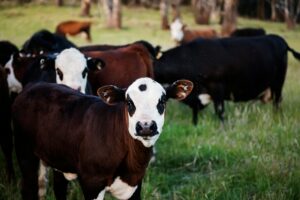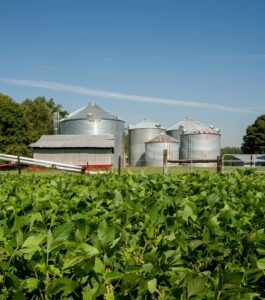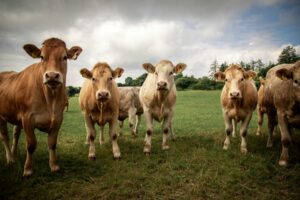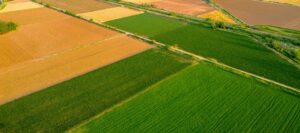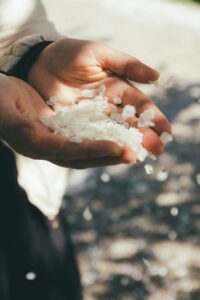Introduction
Irrigation is the artificial application of water to the soil usually for assisting in growing crops. Agriculture that relies only on direct rainfall is referred to as rain-fed farming.
Sources of irrigation water can be groundwater extracted from springs or by using wells, surface water withdrawn from rivers or dams, or non-conventional sources like treated wastewater, desalinated water or drainage water.
Irrigation systems typically being used in South Africa today include:
- Canals
- Flood irrigation
- Draglines, quick-coupling lines
- Pivots
- Sprinklers
- Micro irrigation
- Drip irrigation
These irrigation systems can be defined under the following types:
- Static (micro and sprinkle) – these systems remain static while water is applied.
- Moveable (quick coupling; dragline; hop-along; big gun; rotating boom) – these remain static during irrigation but are moved, manually or mechanically, between irrigations.
- Moving (centre pivot; linear and travelling irrigator), which move by themselves during irrigation.
- Flood (basin; border; furrow; short furrow) – water flows over the soil surface for spreading and infiltration purposes.
Source: https://en.wikipedia.org/wiki/Irrigation (adapted); “Irrigation Basics”, an article by Johannes Maree.
Commercial Farmer Points of Interest
Software for Farmers
Irrigation scheduling is defined as the correct amount of water being applied to a crop at the correct time. We have only a limited resource of water, which should be utilised in the most efficient way possible. By optimising scheduling principles we can:
- Prevent over and under watering
- Facilitate crop manipulation
- Prevent unnecessary crop stress
- Create ideal air-water balance
- Manage soil water buffer
- Optimise salinity management
- Prevent soil compaction
- Save on energy costs
- Promote root development
- Improve fertiliser uptake
- Maximise harvest potential
Water legislation means that a farmer has to budget for how much water will be used. By using scheduling software the farmer can tell exactly how much water he used so that he can estimate how much he’s going to need for the next year as required. Some software companies have addressed the new regulations by developing software solutions that can successfully keep track of water budgeting information and spray records.
One module uses climate and soil moisture information to generate irrigation recommendations. It will also help predict water requirements. By loading this information, you will be able to make use of a second module which controls the irrigation in the field. This module also can determine when to irrigate in order to prevent frost or to cool down the plants by keeping track of temperature readings. By means of radio or of wired links, the pumps and valves in the field are controlled.
Source: DFM Technologies
Precision irrigation means that land can be differentially irrigated according to variations in soil type, topography, soil-water capacity, yield potential. Accepting these differences (and irrigating according to them) translates into less wastage of water and fertiliser.
For the newcomer
Over-irrigating wastes water, and fertilisers and soil nutrients are diluted to below the root zone. And them more fertiliser is used! This leads ultimately to algal blooms and eutrophication downstream.
Find out what support is offered by the SA Irrigation Institute (SABI) and its members. See www.sabi.co.za.
The Department of Water and Sanitation (DWS) also lends support to resource-poor irrigation farmers.
Drip irrigation
Drip irrigation is the ideal solution for small-holders. It uses specially designed pipes pre-fitted with advanced drippers. The irrigation system drips the exact amount of water and nutrients that crops need right at the root zone. Thus, every drop of water is effectively used to raise quality and increase year-round yields.
Why drip irrigation is so successful:
- Keeps soil aerated
- Reduces weed growth
- Cuts down diseases and fungi
- Uniform, efficient water distribution
- Minimised evaporation and water run-off
- Enables easy control of water consumption
- Most efficient, accurate use of water and nutrients
Source: Netafim.
Local business environment
- Irrigation is responsible for 25-30% of national agricultural production. It is used for 90% of high-value crops (including vegetables and fruit) and 25-40% of industrial crops (like sugarcane and cotton) (Du Toit, 2025; WRC, 2018).
- Consult the South African Irrigation Institute (SABI) website, www.sabi.co.za.
- Consult the South African Irrigation Institute (SABI) website, www.sabi.co.za.
- Downloading the latest Agricultural Outlook by the Bureau for Food and Agricultural Policy (BFAP) and doing a search for “irrigation” will bring the reader to relevant passages across all crops where irrigation features. Find the document at www.bfap.co.za.
National Strategy
Department of Water and Sanitation (DWS) www.dws.gov.za
- Selecting the “Projects & Programmes” menu option on the website will provide a spread of available information, including reports and strategic plans.
- Section 26 of the National Water Act (36) of 1998, requires that the abstraction of water for irrigation of crops should be limited, monitored, measured and recorded. Find out more about the Act on the general “Water” page or at www.dws.gov.za.
- Industries with the largest potential contribution to job creation in agriculture are mostly irrigation-based, and so employment could be increased through the expansion of irrigation. The country irrigates some 1,5 million hectares of land and produces about 30% of total output on this land, which is only 10% of our arable land. The National Development Plan (NDP) targeted bringing an extra 500 000ha under irrigation. It shows that even expanding the irrigated area by 14 000ha would create some of the million jobs that the NDP looks for in agriculture.
Department of Agriculture www.nda.gov.za
- Directorate: Water Use and Irrigation Development Ms Mary-Jean Gabriel Tel: 012 846 8567/9 MaryJeanG [at] nda.gov.za, DWUID [at] nda.gov.za
- Directorate: Infrastructure Support Tel: 012 319 846 8502
- Find the document Irrigation Strategy for South Africa on the internet, or approach the Department of Agriculture for it.
- The BFAP Baseline 2025-2034 looks at irrigation under the sub-heading “Resources” in the “Navigating export led growth in a dynamic and uncertain global trade environment” chapter. Find the document at www.bfap.co.za.
- Download the Sustainability Initiative of South Africa (SIZA) “Guidance on South African Legislation” document, available on its website, www.siza.co.za. Water usage is one of the chapters.
- Du Toit M. 2025, December 09. “Regulatory shifts shaping the agriculture sector.” Farmer’s Weekly. Available at www.farmersweekly.co.za/agri-news/south-africa/regulatory-shifts-shaping-the-agriculture-sector/
- Find the Agriculture parliamentary committee meeting of December 2, 2024 at https://pmg.org.za/committee-meeting/40037. The revitalisation of irrigation schemes in South Africa was one of three issues discussed.
Role players
View the Premium Listings below (scroll down or click on “Premium Listings” on the Table of Contents to the right).
Further reference:
Training and Research
- The Agricultural Colleges present short courses on irrigation for small scale as well as for commercial farmers. These include a basic introduction to irrigation planning, examination of soil, economics and irrigation scheduling. Taung Agricultural College is accredited to offer Diploma in Irrigation Management course at NQF level 6. Find contact details on the “Agricultural education and training” page.
- Companies involved provide training on practical aspects of irrigation, such as installation, maintenance and management of irrigation systems.
Companies involved
- Find the list of SABI members at www.sabi.co.za.
Websites and publications
Visit the websites listed earlier on this page.
From SABI:
- SABI Magazine/Tydskrif is published by SABI every second month. It is distributed to irrigation farmers and associated professionals in South Africa. The publication gives the reader first hand information and a range of topical and technical articles on the irrigation industry in South Africa. Visit www.sabi.co.za for more information and to subscribe to the magazine.
- Newsjet is the newsletter of SABI. Find a copy on their website.
- Irrigation Design Manual – usually given as part of the Irrigation Design Course. Contact SABI for a copy.
The Water Research Commission has numerous relevant publications. One of these is Irrigation water measurement – Guidance for water user associations. Water user associations (WUAs) will be assisted greatly by these guidelines addressing the choice, installation and management of water measuring devices for canal, pipeline and river distribution systems. This and many other publications are available from the Water Research Commission. Call 012 761 9300, email orders [at] wrc.org.za after viewing www.wrc.org.za.
One of the reports by the WRC looks at possible water treatment techniques for farmers employing irrigation water from rivers that are increasingly polluted. Download “Scoping study on different on-farm treatment options to reduce the high microbial contaminant loads of irrigation water to reduce the related food safety risk” at www.wrc.org.za.
SUSFARMS, the Sustainable Sugarcane Farm Management System, deals with irrigation. Contact the South African Sugarcane Research Institute (SASRI) for more information. Call 031 508 7500 or visit https://sasri.org.za/.
Call 012 842 4017 or email iaeinfo [at] arc.agric.za for the following publications, available from the ARC-Agricultural Engineering:
- Irrigation design manual (Planning and design of irrigation systems)
- Besproeiingsontwerphandleiding (beplanning en ontwerp van besproeiing stelsels)
- Besproeiingsbedryfshandleiding (installering, bestuur en instandhouding van besproeiing stelsels)
- Irrigation User’s Manual (installation, management and maintenance of irrigation systems)
- Besproeiingsontwerphandleiding / Irrigation Design Manual on cd (pdf-format)
- Besproeiingsbedryfshandleiding/Irrigation Users’ Manual on cd (pdf-format)
- The efficient use of labour in sprinkler irrigation systems
- The effects of wind on sprinkler irrigation
- Aspects to consider when selecting sprinklers for use in irrigation systems
- Critical elements which influences the efficiency of small-scale farm sprinkler irrigation systems
- Ingenieursaspekte betrokke by ondergrondse drupbesproeiing
- Engineering aspects of sub-surface drip irrigation
- Laedruk vloeibeheerklep
- Treatment of low quality water for drip irrigation systems
- The performance and care of drip irrigation emitters
- Ondersoek na materiale vir kanaalbelyning
- Investigation into materials for lining of canals
- Petrol-aangedrewe besproeiingspomp vir beginnerboere
- Petrol-driven irrigation pump for emerging farmers
- An evaluation of some irrigation methods for small vegetable gardens in remote rural areas
- Handleiding vir die evaluering van besproeiingstelsels
- Manual on the evaluation of irrigation systems Irrigation made easy (training manual)
- Practical water conserving techniques applied to small-scale irrigation
- Alternative small-scale irrigation technologies for domestic utilization and production use
Some articles
- SABI Magazine/Tydskrif is published by SABI every second month. It is distributed to irrigation farmers and associated professionals in South Africa. The publication gives the reader first hand information and a range of topical and technical articles on the irrigation industry in South Africa.
- Read our blogs “We studied smallholder farming in three African countries for 10 years: why profitable irrigation is key” and “Consider silt loads before specifying pumping systems“.
- Tembo P. 2025, December 03. “Maximising water efficiency with drip irrigation.” Food for Mzansi. Available at www.foodformzansi.co.za/maximising-water-efficiency-with-drip-irrigation-netafim-sadc
- Van der Merwe J. 2025, October 27. “Farmers must prepare for GlobalGAP water-use scrutiny.” Farmer’s Weekly. Available at www.farmersweekly.co.za/agri-news/south-africa/farmers-must-prepare-for-globalgap-water-use-scrutiny/
- Van der Merwe J. 2025, October 21. “New pivot for Stellenbosch University boosts agriscience offering.” Farmer’s Weekly. Available at www.farmersweekly.co.za/agri-news/south-africa/new-pivot-for-stellenbosch-university-boosts-agriscience-offering
- Bryan E & Ringler C. 2023, April 18. “Feeding Africa: how small-scale irrigation can help farmers to change the game”. The Conversation. Available at https://theconversation.com/feeding-africa-how-small-scale-irrigation-can-help-farmers-to-change-the-game-202773
- Creamer Media Reporter. 2023, March 15. “Constitutional Court ruling a crucial victory for water rights holders, says AgriSA”. Engineering News. Available at www.engineeringnews.co.za/article/constitutional-court-ruling-a-crucial-victory-for-water-rights-holders-says-agrisa-2023-03-15
- Botha, L. 2019, February 15. “Dramatic savings with low-flow drip irrigation”. Farmer’s Weekly. Available at www.farmersweekly.co.za/crops/field-crops/dramatic-savings-with-low-flow-drip-irrigation/
- Reporter. 2018, March 6. “FRUITLOOK: the ideal tool to assist irrigation farmers”. AgriProbe. Available at www.elsenburg.com/drought/?p=778
- Phillips L. 2017, May 19. “Know the facts before switching irrigation systems”. Farmer’s Weekly. Available at www.farmersweekly.co.za/crops/field-crops/know-facts-switching-irrigation-systems/
International
- Find the irrigation tutorials (USA) at www.irrigationtutorials.com
- International Commission on Irrigation and Drainage (ICID) www.icid.org
- Irrigation Association Australia www.irrigation.org.au
- Irrigation Association (USA) www.irrigation.org
- International Water Management Institute www.iwmi.cgiar.org
- Irrigazette www.irrigazette.com
- Irrigation UK www.ukia.org

